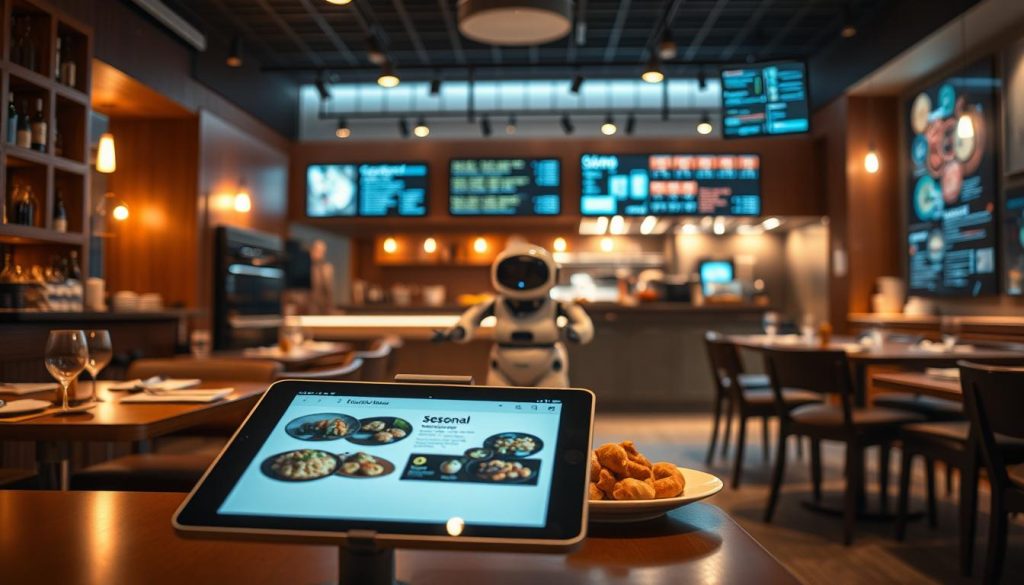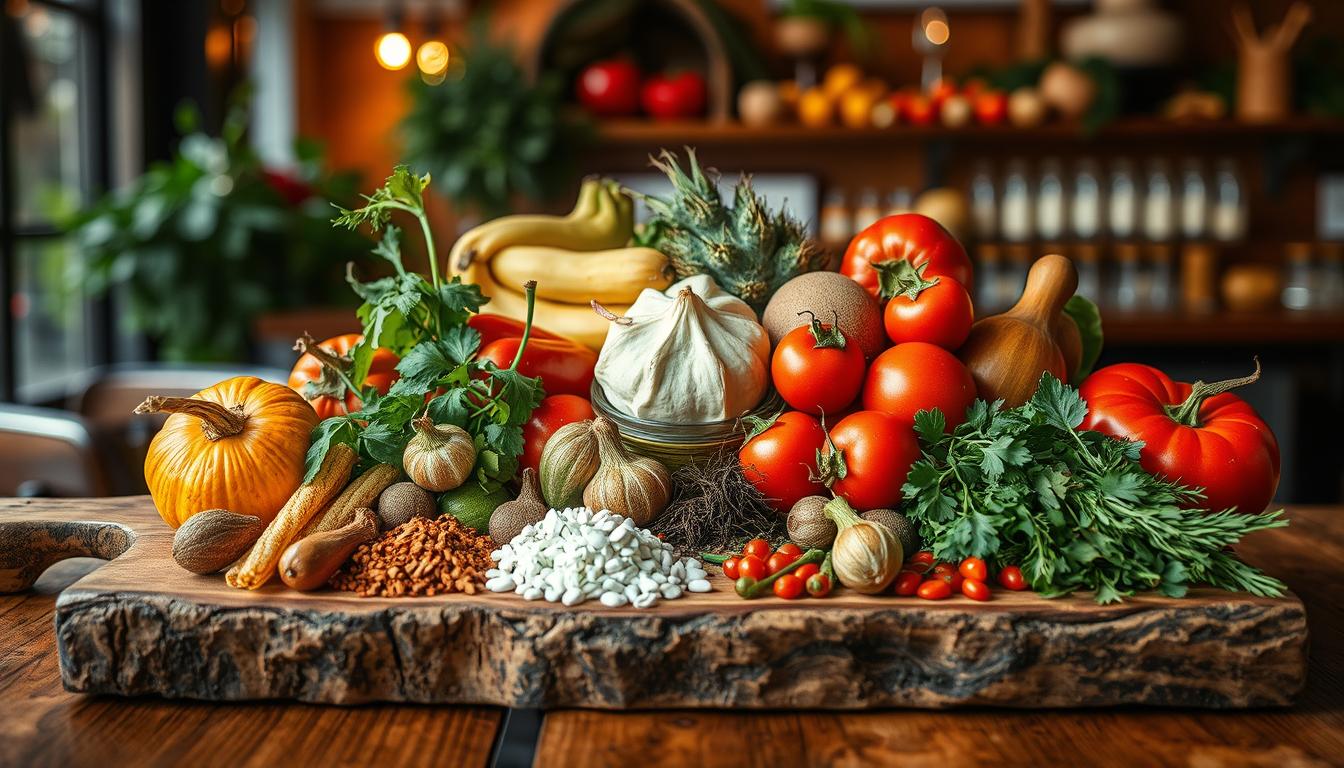In the fast-paced world of food, seasonal menu adaptation is key for restaurants in Poland. Using local produce makes our menus exciting and supports sustainable trends. This approach also lets us showcase the best of Polish cuisine and keeps our customers coming back.
Studies show that seasonal menus boost customer happiness. This highlights the need to keep up with nature’s changes. It’s a way to make our offerings more appealing and build lasting customer loyalty.
Understanding the Importance of Seasonal Menus
Seasonal menus bring many benefits to our restaurants. They meet the current demand and trends in food. By using seasonal ingredients, we offer dishes that are fresh and unique.
This approach makes dining more enjoyable. It lets us cater to our customers’ love for variety. It also creates a memorable experience for them.
Seasonal menus also help the environment. Using local produce reduces our carbon footprint. It supports local farmers too.
More and more people want to eat at places that care about the planet. Telling customers where their food comes from strengthens our bond with them.
Seasonal menus are also good for business. They use fresher, cheaper ingredients, saving us money. They also help us attract more customers.
Marketing seasonal dishes can really help our sales. People love trying new foods that match the season. This makes our restaurants leaders in the food world.
Your Local Market: Embracing Polish Ingredients
Using Polish ingredients in our menu lets us celebrate Poland’s rich food culture. Buying local produce makes our dishes taste better and helps our farmers. Ingredients like beetroots, cabbages, oysters mushrooms, and top-quality dairy are key to our tasty meals.
Choosing local ingredients means our dishes show off Poland’s unique tastes. Each item adds special flavours, making our food fresh and lively. Supporting local suppliers also builds a community and promotes green practices.
Working with Polish ingredients lets us get creative with traditional recipes. We add new twists while staying true to the classics. Our focus on local produce strengthens our ties with farmers and shows our commitment to the environment. As we update our menu, using local ingredients will make our dishes even better.
Seasonal Menu Adaptation: A Key to Success
In the fast-changing world of food, it’s key to keep your menu fresh. By using seasonal ingredients, we stay relevant and attract more customers. This way, we offer the best of what’s in season, keeping up with food trends.
Changing our menu with the seasons lets us show off the best flavours of each time. It makes dining with us exciting and keeps guests coming back. By always updating our menu, we meet our guests’ tastes, making seasonal changes a big part of our plan.
| Season | Typical Ingredients | Popular Dishes |
|---|---|---|
| Spring | Asparagus, peas, lamb | Asparagus Risotto, Lamb Chops |
| Summer | Tomatoes, corn, berries | Caprese Salad, Corn Chowder |
| Autumn | Pumpkin, apples, squash | Pumpkin Soup, Apple Crumble |
| Winter | Root vegetables, game meats, citrus | Beetroot Salad, Roast Venison |
By focusing on seasonal menus, we honour old traditions and meet today’s food lovers. This way, we ensure our dishes are always in tune with what people want to eat.
Surveying Seasonal Trends: How to Stay Ahead
Keeping up with seasonal food trends is key for our menu updates. We use market research to understand what our customers like. Looking at social media and food blogs helps us see what’s new and popular.
Knowing these trends lets us change our menus to match current tastes. This makes our customers happier and can increase sales. We must always check the market and update our plans to stay ahead.
Experimenting with New Flavours for Seasonal Appeal
In the lively world of Polish cuisine, trying new flavours is key. It makes diners excited about what’s new. We mix old recipes with new ways to cook, showing off local foods. This keeps our menu exciting and fresh.
Incorporating Local Specialties
Poland has many local foods, each with its own taste. Using these ingredients connects us with our customers. It also shows the culture and supports the community.
Adding things like oscypek cheese, wild mushrooms, or local honey makes our dishes special. They mix old and new, pleasing everyone.
Testing New Recipes with Seasonal Ingredients
Using fresh, in-season foods is at the heart of our appeal. Changing our menu with these ingredients brings creativity. It lets guests try new and interesting tastes.
Seasonal fruits and veggies are our inspiration. They help us make dishes that excite the senses. This makes our dining experience better and more exciting.
Engaging with Your Customers’ Preferences
Understanding what our customers like is key to changing our menus well. By talking to them, we learn what they want. This helps us make our menus better.
Utilising Feedback for Menu Changes
Good feedback systems help a lot. Comment cards let people share their thoughts. Social media is great for quick chats with customers. Talking to them in person gives us the best ideas for our menu.
Creating Polls and Surveys for Seasonal Input
Polls and surveys help us get feedback all year round. They let customers tell us what they want for new menu items. By asking fun questions, we make our customers feel part of our team.
| Feedback Mechanism | Advantages | Challenges |
|---|---|---|
| Comment Cards | Direct insights from customers | May lack detailed feedback |
| Social Media | Real-time engagement | Requires active monitoring |
| Direct Conversations | Builds rapport with customers | Time-intensive |
| Polls and Surveys | Structured feedback | Potential low participation rate |

Choosing the Right Suppliers for Fresh Produce
Choosing reliable fresh produce suppliers is key to our seasonal menu’s success. Quality must always be our first concern when picking ingredients. This is because it directly affects the taste of our dishes.
It’s also important to pick suppliers who care about the environment. Suppliers who use eco-friendly methods can boost our brand’s image.
We need to think about how well suppliers can meet our seasonal needs. Our partnerships with suppliers should be strong and open. This way, we can get the freshest ingredients on time.
Good supplier relationships help us work better together. We can share ideas and adjust to market changes easily.
Building long-term partnerships with trusted suppliers is vital. It ensures we always have top-quality ingredients. This makes our dining experience better for our customers, letting them enjoy the best of seasonal produce.
Creating Seasonal Marketing Campaigns
In the food and hospitality world, making engaging seasonal marketing campaigns is key. We use social media to show off our new menus and seasonal dishes. This makes people want to try our food, not just for taste, but for the experience of new flavours.
Leveraging Social Media for Promotions
Social media helps us reach more people and stay fresh. We share our seasonal menu changes with great pictures and stories. This way, we tell our followers about special deals and new dishes that match the season.
We make our posts look good and tell stories to get people excited. This helps our seasonal marketing shine.
Collaborating with Local Influencers and Chefs
Working with local influencers and chefs boosts our marketing. They bring their fans to our seasonal dishes, adding a real touch to our message. Their support builds trust and brings in people who want to try our new food.
The Art of Menu Design for Seasonal Appeal
Creating a seasonal menu is all about thoughtful design. It must look good and match the season. We choose colours, fonts, and images that fit each season. For example, autumn calls for orange and brown, while spring is perfect for pastels.
Good menu design does more than look nice. It helps customers make choices and makes dining memorable. Using the right words to describe dishes is key. It makes them sound appealing and exciting.

Adding seasonal themes to our menus connects diners to nature. This makes them appreciate the fresh ingredients we use. A well-designed menu also creates a warm and welcoming atmosphere, fitting each season perfectly.
Maximising Waste Reduction through Seasonal Offers
We know how important waste reduction is for a greener kitchen. Seasonal offers help us cut down on food waste and make our meals better. Working with local farmers means we get fresh food and support our community.
Implementing Creative Use of Ingredients
Creative cooking lets us use every part of an ingredient. Stems, leaves, and peels add new tastes and textures to our food. We create special recipes that show off these often-overlooked parts.
This approach not only helps the planet but also makes our dishes stand out. It makes dining with us a memorable experience.
- Incorporate vegetable skins into chips or broths.
- Use herb stems in marinades and pestos.
- Transform fruit peels into chutneys or syrups.
By focusing on sustainability, we teach our team and guests to care for our planet. This mindset makes every meal more special and meaningful.
Training Staff on Seasonal Menus and Changes
Effective staff training is key to better customer service. It ensures our team knows our menu well. When we change our seasonal menus, it’s vital to train our staff. This way, they can talk to customers with confidence.
We can set up a detailed training programme for our staff. It should cover all about our new seasonal dishes. This includes:
- Deep dives into new dishes, like ingredients, how they’re made, and tastes.
- Why we change our menu seasonally, focusing on local and fresh ingredients.
- Practice chats with customers to improve their answers to questions.
- Updates on new items, so our staff is always ready to serve well.
By focusing on staff training, we build a team that knows our menu inside out. They can explain the reasons behind our seasonal changes. This leads to happier customers who value our service and food.
Utilising Technology for Seasonal Adaptation
The restaurant industry is always changing. To stay ahead, using technology is key. Point of Sale (POS) systems are a big help in adapting to the seasons.
POS systems help us track sales. This lets us see which dishes are popular. We can then update our menu to meet customer tastes.
Using POS Systems to Track Seasonal Sales
POS systems make tracking sales easy. They also help us run our business better. With their reports, we learn what sells well and what doesn’t.
This info helps us improve our menu. We can buy the best ingredients for the season. Technology helps us stay on top of trends and keep our menu fresh.

Highlighting Sustainability in Your Seasonal Offerings
In today’s dining world, focusing on sustainability is key. We show our commitment to eco-friendly practices. This attracts people who care about the environment.
By talking openly about where we source our food, we connect with our customers. We choose local, seasonal ingredients to cut down on emissions and support local farmers. This way, our dishes are fresh and we’re good for the planet.
We also aim to reduce waste in our kitchen. We find creative ways to use every ingredient. For example, we make stocks from vegetable scraps or compost them. This helps us lower our impact on the environment and makes our food better.
Our efforts build trust and loyalty with our customers. By being open about our eco-friendly practices, we help our diners make choices that match their values. This makes us a leader in sustainable dining.
Planning Ahead: The Role of Seasonal Calendar
A well-structured seasonal calendar is key for good menu planning. It helps us know when ingredients are in season, track specials, and keep up with new food trends. This way, we can offer a menu that’s always fresh and appealing to our customers.
Here are some benefits of using a seasonal calendar for menu planning:
- It helps us plan for seasonal ingredients, ensuring we use the freshest ones.
- It helps us manage food costs by buying what’s available.
- It makes our customers happier by giving them dishes that match the season.
- It makes changing our menu easier, introducing new dishes smoothly.
Using a seasonal calendar shows our dedication to quality and keeps us ahead in the world of seasonal dining. It helps us create a culture of innovation, making our restaurant successful.
Feedback Loop: Evaluating the Success of Menu Changes
Creating a strong feedback loop is key to checking if our seasonal menu changes work. This helps make our customers happy and boosts our menu’s success. By listening to what customers say, we can make our menu better and meet their needs.
We use different ways to get feedback:
- Surveys to see what customers like and think.
- Looking at online reviews for menu insights.
- Talking directly to customers at our place.
Using numbers like how often people come back and what they order helps us see what’s working. Also, watching feedback patterns over time helps us adjust our menu. This way, we can keep up with changing tastes and what customers want.

Showcasing Seasonal Menu Innovations in Your Establishment
To keep customers coming back, we need to show off our seasonal dishes. Hosting menu launch events lets us celebrate new dishes, making it fun for everyone. It’s a great way to build a community feeling as people try new things together.
Using table tent marketing adds to the fun. These cards highlight our special seasonal dishes and unique ingredients. They make it easy for customers to find and enjoy our latest creations, boosting interest and encouraging more people to try them.
Resources for Continuous Improvement in Menu Development
Seeking excellence in menu development is key. We use many resources to improve. By learning from culinary education, we understand new techniques and flavours. This helps us create menus that are fresh and meet current trends.
Being part of the culinary community is also important. We learn from others and share our ideas. This helps us stay creative and informed about new food trends and sustainable practices.
Keeping up with industry trends is essential. We do this by reading food magazines, going to events, and taking workshops. This effort makes us better chefs and improves our guests’ dining experience.







